Community Projects, Do Space News
Cool Projects Made by Make.Hack.Build.
May 4th, 2018 | Ruth Williams, Community Learning Specialist

In our first ever Make.Hack.Build. session, sixteen participants spent eleven weeks learning how to create and design physical technology, engaging in a mini-hackathon, and showcasing their projects at the Omaha Mini Maker Faire. Ten makers participated in the Faire and ran their own booths.
3D Printed Allergy Station made by Anjali, Apurva, Lilian, Nikita, and Rohini

Anjali, Apurva, Lilian, Nikita, and Rohini worked together to invent an allergy station for helping nurseries, daycares, and hospitals keep all their sanitary products in one place. The dispenser has separate compartments to hold tissues and hand sanitizer. The group designed their model in SketchUp and 3D printed it.
Cure for Laziness made by John

John made an automated chicken coop to give him more time to sleep in. You can read more about his project here.
Cardboard PiCade made by Alex

Alex made a cardboard arcade with a Laser Cutter and the Raspberry Pi. He designed and assembled the arcade case and used RetroPi software to load old school games onto the Raspberry Pi.
EZ Keys made by Deqlan and Zachary

Deqlan and Zach invented an accessible keyboard to help young children play Minecraft. The keys have various shapes and colors that allows toddlers quickly understand how to use the Minecraft controls. They made it by re-purposing an old keyboard and toy pieces to create the keys.
3D Printed DnD Figurine made by Elise

Elise wanted to create DnD figurines for her friends to make their sessions much more immersive. She started by designing and drawing her character on her tablet. She then 3D modeled it in Blender and 3D printed it.
2D Printer made by Lucas

Lucas wanted to see more interesting 3D printers, so he made a 2D printer. He scavenged parts from old DVD writers and other items. He then assembled the 2D printer with the components he retrieved and with Arduino Nano.
Piano Memory Game made by Lachlan

Lachlan invented an electronic piano memory game with a Raspberry Pi, various electronic components, and a wooden box. He programmed the game in python and loaded it to the Raspberry Pi. The goal of the game is to play the corresponding note that the game played to the user.
Everyone did a great job with their projects at the Maker Faire! The next Make.Hack.Build. session’s topic is game development and it starts on May 24. You can read more about our Make.Hack.Build. program and apply for the Summer 2018 Session, by clicking here.